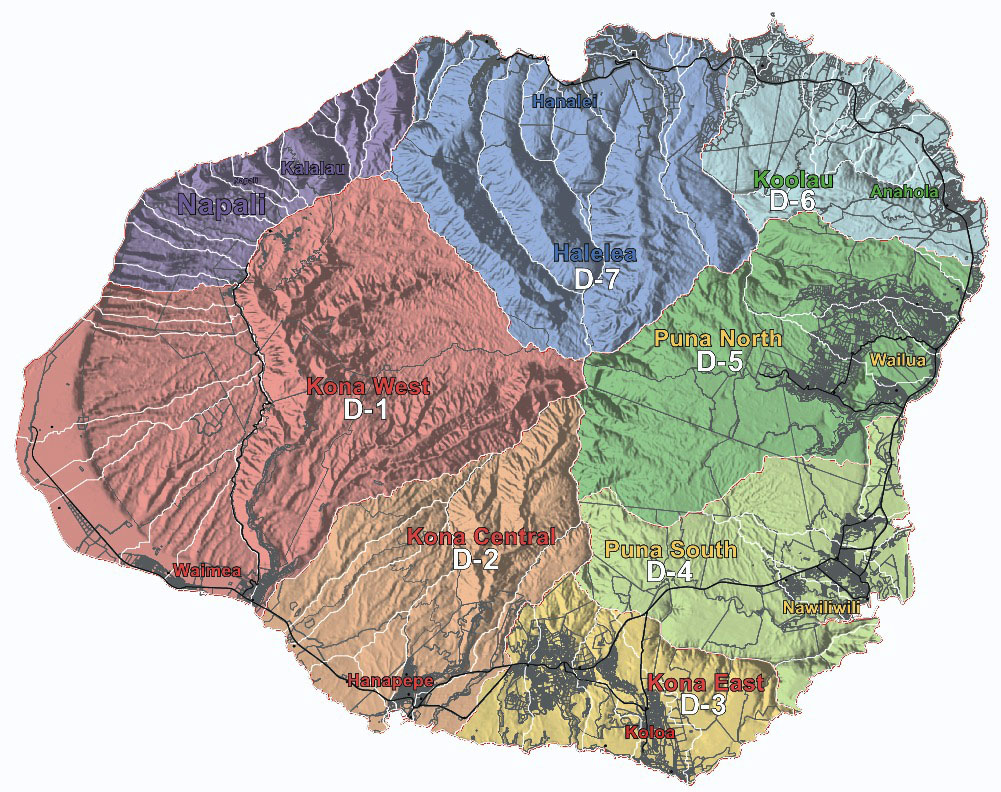|
[Normally
these columns are scheduled to appear every other Sunday in the Kauai
Garden Island News.The final published version may vary from this text
as TGI retains the right to correct and edit the material. The
copyright to the published version is held by TGI owner Kauai
Publishing. Some material in TGI columns may have appeared on
www.islandbreath.org already.]
by Juan Wilson on 30 March 2008 Revision 8.0 08028
So, who needs a mayor?
Looking back over the last six or seven years, it seems to me that
Kauai doesn't need a County Mayor, Planning, and Public Works
Department, as much as Kapaa and Koloa towns do.
In other words, since 2000, when The Kauai General Plan was last
revised, our county government has largely ignored the public will. The
core of the General Plan was to protect and enhance the rural lifestyle
of Kauai. Our county government has failed to protect our island from
greedy speculators, agland subdivisions and visitor-industry intrusion
into our neighborhoods. They have not addressed GMO herbicide spraying
near schools or saved the monkeypod trees of Koloa.
Towns like Koloa would have done much better with their own Mayor and
local government services, rather than the current county government.
Why? Accountability! Certainly, if the Koloa monkeypod trees were
threatened, the community would have had better leverage with the
Knudsen Trust if it was dealing with the Koloa Planning Department. .
This article advocates that Kauai begin the process, through the
Charter Commission, to create local governance by townships (municipal
corporations), centered around our largest population centers and
extending to the boundaries of regional watershed districts.
It's been a year already
In previous articles in this series we have examined sustainability and
better environmental land management. The reason for the concentration
of these themes goes back to the premise of the first TGI Island Breath
article on March 25th 2007, titled “HO'OKAHI KAUAI”, which identified
"the solitude, separateness and oneness of Kauai". I wrote then that
“we are a very isolated place now, and I think the future will make it
even more so.”
Back in March of 2007, light sweet crude oil was selling for as little
as $56 dollars a barrel, half the recent peak high of $112 a barrel.
At about that time another effort began - the Eco-Roundtable. On
February 13th 2007 was the first of several gatherings organized by
Malama Kauai (www.malamakauai.org).
These meetings brought together many of the ecological, conservationist
and progressive organizations on the island, including Apollo Kauai,
The Kauai Farm Bureau, Kauai Taro Growers Association, National
Tropical Botanical Gardens, Save our Seas, the Waipa Foundation, the
Sierra Club and many more.
In response to the concerns expressed at the first Eco-Roundtable,
Jonathan Jay and I began an effort to produce base maps of Kauai for
sustainability planning. We studied maps of the Hawaiian islands going
back to 1837. We tried to resolve conflicting ahupuaa and moku district
information for Kauai. We began delineating a district map for Kauai
that respected the environment and the Hawaiian culture, while
attending to the current state of island development and population
distribution.
We presented our first results at the May 2007 Eco-Roundtable Meeting.
In determining what might be Kauai districts we held to three
principles as “given”. We would...
A) Not use modern “unnatural” property lines as ahupuaa boundaries.
B) Conform district boundaries to natural watershed features.
C) Honor the five widely accepted moku boundaries of Kauai.

Kauai Okana Districts
There was some controversy using these principles, but it allowed us to
make variations of districts that emphasized different objectives
without violating the cultural and environmental concerns that
motivated us in the first place. The early results of those efforts
were published in June of 2007 in two articles in this TGI column.
We are now using the terminology of “'okana” and not “moku”, "kalana"
or “ahupuaa” for these districts. The ‘okana are made up of moku and
ahupuaa. In the online Hawaiian Dictionary (www.wehewehe.org) an ‘okana means “a district or subdistrict, usually comprising several ahupua‘a”.
The results were eight ‘okana or districts:
1) Kona West (Polihale to Waimea);
2) Kona Central (Makaweli to Numila);
3) Kona East (Kalaheo to Mahaulepu);
4) Puna South (Kipu Kai to Nukolii);
5) Puna North (Wailua to Kealia);
6) Koolau (Anahola to Kilauea)
7) Halelea (Kahiliwai to Kee Beach) and
8) Napali (Kee Beach to Polihale).
How others divide up their land
On mainland America, some states don’t use the term “County” at all. In
Alaska they subdivide the state into Bureaus. In Louisiana they do it
by Parishes.
Whereas in Massachusetts, counties currently exist, but mostly as just
lines on a map. They have no real county government services. In next
door Connecticut they don’t have counties at all, only towns.
New York, Like Hawaii, has counties, but the counties are divided in a
variety of ways. I lived for ten years in New York’s Chautauqua County.
It is rural, a bit larger than Kauai, and has a population of about
140,000. The county is divided into 27 townships that cover all the
land (except for two incorporated cities).
In Chautauqua, each town has its own Supervisor (mayor) and four member
Board of Supervisors (council). Each town also has its own Highway
Supervisor, Police, Magistrate, Town Clerk, Assessor, and even Town
Historian.
Of the several places I have lived, I found the Connecticut and
Chautauqua township models the best for local governance.
District Council Representation
The upcoming 2008 election will be a time to evaluate Kauai County
Charter amendments. Jonathan Jay has been trying to formulate a new
charter amendment that would transform our seven person County Council
to district representation based on the cultural and natural divisions
we hoped to achieve with our map project. The plan is that each of the
seven populated districts (not counting the Napali District) will have
a county council representative.
Jay's strategy has been to keep a seven person county council and make
the least charter change necessary to obtain a better representation of
island issues. Due to a US Supreme Court decision on the need for
one-person-one-vote in all elected representative governing bodies
(except the US Senate), the representation of unequally populated
districts is complicated. You can see the current version of this
charter amendment effort at http://ponokauai.org.
I applaud this effort and hope it is approved this year. It is a step
in the right direction, but I think it is leading to something more."
Creating our own Townships
Historically the granting of a town charter gave a settlement and its
inhabitants the right to town privileges under the feudal system.
People who lived in chartered towns were burghers, as opposed to serfs
who lived in villages. Towns were often "free", in the sense that they
were directly protected by the king or emperor, and were not part of a
feudal fief.
After experiencing a number of other systems and living in Hawaii for
almost a decade, I propose the following path to better local
government. It could become a charter amendment in our 2010 Kauai
election.
My proposal is to use the same seven ‘okana for townships as Jonathan
and I have proposed for council districts as township boundaries. But
the townships would not include the Napali Coast and the central
conservation district (including the Alakai Swamp). Those two areas
would be held in common and not part of any municipality.
These 'okana townships would include all the populated areas of the
island and all the major population areas would be contained discreetly
within the ‘okana (without spreading across borders).
Each municipality would have its own Mayor, Town Council, Town Planning
Department, and even Public Works Department. There would be a Town
Hall in each 'okana, a Public Works Garage, Town Transfer Station and
even County/State Office. You wouldn't have to go to Lihue to renew a
driver's license or pick up a form. It would be in your town.
If this year district representation gets on the ballot, we will know
this is an important issue to Kauai residents. It would certainly make
moving towards district townships easier. But even if such an amendment
were not to pass, I would still strongly recommend we begin governing
by locally with a 2010 charter amendment that would set up municipal
corporations as townships.
A New County Council
In this township proposal there would still be a County Council to
deliberate island-wide issues like mass transit, energy distribution,
and ocean resources. But this new council would be larger than our
current seven person. Its number would be determined by the number of
people residing in the least populated township as the number
represented by a single councilperson. Other townships would have a
proportional number of council representatives as the least populated
township
Today what would be the Township of Hanalei in the district of Halelea
has the smallest population. That would mean that each County Council
member would represent about 3,600 people and consequently, the county
council would have seventeen members. Council member numbers would vary
with the Census every ten years.
As a result Halelea would have one representative; Koolau - two; Puna
North - six; Puna South - four; Kona East - four; Kona Central - two;
and Kona West - two representatives. This would be a county council of
twenty-one regional members. Part of the reason for this expansion is
to meet the one-person-one-vote requirement, but it would also be a
better deliberative body than our seven person council.
It seems to me that the virtues of this town governing system would be
that it would do well in a worse case economic future and other
expected adversities, but would also serve well, in the best of times,
to preserve and strengthen Hawaiian culture and the importance of
community values.
|


